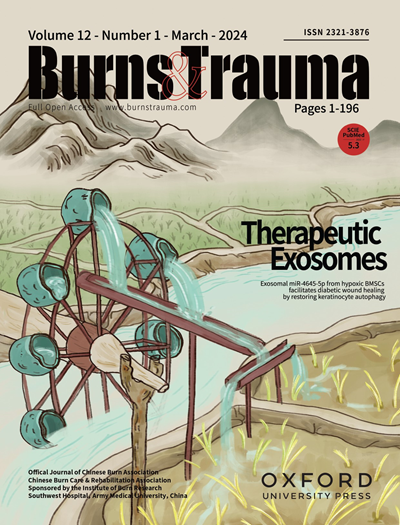Histone Lactylation Exacerbates Acute Lung Injury in Septic Mice by Promoting Ferroptosis in Pulmonary Microvascular Endothelial Cells
IF 9.6
1区 医学
Q1 DERMATOLOGY
引用次数: 0
Abstract
Background: Circulating lactate is associated with poor prognosis in sepsis-induced acute lung injury (S-ALI). However, it remains unclear whether microvascular dysfunction, a hallmark of S-ALI, is related to circulating lactate levels and what the underlying mechanisms are. The aim of this study was to investigate the role and mechanisms of lactate in pulmonary microvascular dysfunction in S-ALI. Methods: The effects of lactate on pulmonary microvascular function were assessed in a septic mouse model. Primary mouse pulmonary microvascular endothelial cells (MPMVECs) were isolated to evaluate the impact of lactate on MPMVEC permeability. Transcriptomic sequencing was employed to investigate the involvement of lactate in regulating MPMVEC ferroptosis, and the results were validated by in vivo and in vitro experiments. Histone lactylation was identified as a regulator of lipid peroxidation and iron homeostasis dysregulation in lactate-induced ferroptosis in MPMVECs. Gain- and loss-of-function approaches were used to assess the role of histone lactylation in regulating ferroptosis and pulmonary microvascular dysfunction. Correlations between serum lactate and ferroptosis levels and their associations with patient prognosis were investigated in patients with sepsis-associated acute respiratory distress syndrome (S-ARDS). Results: The mouse serum lactate level reached a peak at 18 hours after caecal ligation and puncture surgery. Elevated lactate levels during sepsis promoted ferroptosis in PMVECs, leading to increased pulmonary vascular permeability and exacerbation of ALI. Mechanistically, lactate increased the lactylation of histone H3 at K18 (H3K18la), which promoted ACSL4 transcription in MPMVECs, resulting in excessive lipid peroxidation. Additionally, elevated H3K18la promoted LC3 transcription and indirectly upregulated NCOA4 expression through the transcription factor GATA2, facilitating ferritinophagy. Serum lactate levels were significantly correlated with ferroptosis levels in S-ARDS patients, and both were associated with poor patient prognosis. Conclusion: This study revealed a critical role for high lactate-derived histone lactylation in PMVEC ferroptosis and the progression of ALI during sepsis, providing new insights and potential therapeutic mechanisms.组蛋白乳酸化通过促进肺微血管内皮细胞的铁凋亡而加重脓毒症小鼠的急性肺损伤
背景:循环乳酸与脓毒症引起的急性肺损伤(S-ALI)的不良预后有关。然而,目前尚不清楚微血管功能障碍(S-ALI的一个标志)是否与循环乳酸水平有关,以及潜在的机制是什么。本研究旨在探讨乳酸在S-ALI患者肺微血管功能障碍中的作用和机制。方法:采用脓毒症小鼠模型,观察乳酸对肺微血管功能的影响。分离小鼠原代肺微血管内皮细胞(MPMVEC),观察乳酸对MPMVEC通透性的影响。采用转录组测序方法研究乳酸对MPMVEC铁凋亡的调控作用,并通过体内和体外实验验证了这一结果。在乳酸诱导的mpmvec中,组蛋白乳酸化被确定为脂质过氧化和铁稳态失调的调节因子。使用功能获得和功能丧失方法来评估组蛋白乳酸化在调节铁吊和肺微血管功能障碍中的作用。探讨脓毒症相关急性呼吸窘迫综合征(S-ARDS)患者血清乳酸和铁下垂水平的相关性及其与预后的关系。结果:小鼠血清乳酸水平在盲肠结扎穿刺后18小时达到峰值。脓毒症期间乳酸水平升高促进pmvec的铁上吊,导致肺血管通透性增加和ALI加重。从机制上讲,乳酸增加了K18 (H3K18la)处组蛋白H3的乳酸化,促进了mpmvec中ACSL4的转录,导致过度的脂质过氧化。此外,升高的H3K18la促进LC3的转录,并通过转录因子GATA2间接上调NCOA4的表达,促进铁蛋白自噬。S-ARDS患者血清乳酸水平与铁下垂水平显著相关,两者均与患者预后不良相关。结论:本研究揭示了高乳酸源性组蛋白乳酸化在脓毒症期间PMVEC铁凋亡和ALI进展中的关键作用,提供了新的见解和潜在的治疗机制。
本文章由计算机程序翻译,如有差异,请以英文原文为准。
求助全文
约1分钟内获得全文
求助全文
来源期刊

Burns & Trauma
医学-皮肤病学
CiteScore
8.40
自引率
9.40%
发文量
186
审稿时长
6 weeks
期刊介绍:
The first open access journal in the field of burns and trauma injury in the Asia-Pacific region, Burns & Trauma publishes the latest developments in basic, clinical and translational research in the field. With a special focus on prevention, clinical treatment and basic research, the journal welcomes submissions in various aspects of biomaterials, tissue engineering, stem cells, critical care, immunobiology, skin transplantation, and the prevention and regeneration of burns and trauma injuries. With an expert Editorial Board and a team of dedicated scientific editors, the journal enjoys a large readership and is supported by Southwest Hospital, which covers authors'' article processing charges.
 求助内容:
求助内容: 应助结果提醒方式:
应助结果提醒方式:


